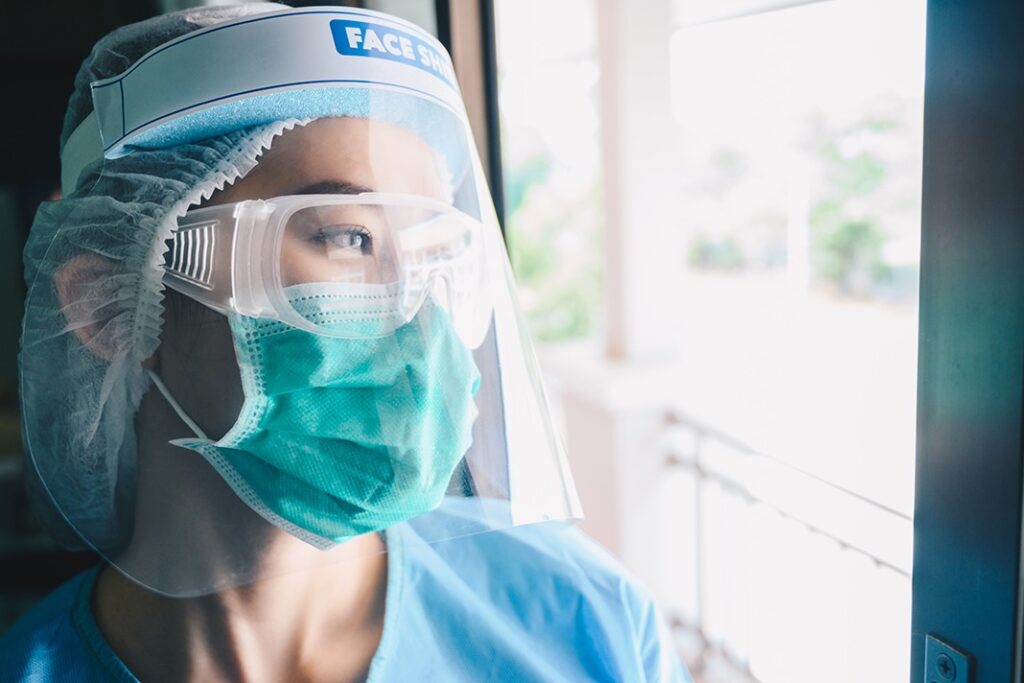Last updated on October 14th, 2020 at 03:02 pm
 If you own a dental practice, where exactly should you be placing the bulk of your focus? Specifically, right now?
If you own a dental practice, where exactly should you be placing the bulk of your focus? Specifically, right now?
You’ve had a lot “coming at you” these past six months, both personally and professionally. From being forced to shut down or reduced to emergency care, possibly laying staff off, trying to hire them back (with varying degrees of success), adopting all types of new protocols, extra PPE, changes to your schedule. I could go on – but I don’t think I have to.
So, yes, a lot has changed. And having lived through many of these changes, you’re well aware of what they are. But that said, there are a few other changes, now developing into “trends,” that you may not be aware of.
You may see some of the effects of these in your office (reduced patient flow, patients unable to pay for comprehensive treatment, or an empty hygiene schedule in October, November, or beyond). Now, if you’re not aware of what’s behind all of this, you lose the ability to be proactive, potentially threatening the success of your practice and by extension yourself, your family, and your team.
 Working so closely with the dental industry going on our third decade, we saw a lot of this coming as the COVID crisis developed. And advised our clients throughout accordingly. As we rolled out these strategies to MGE Clients, we had the added advantage of working with an inordinately large client base (of private dental practice owners), in 48 US states and 5 Canadian Provinces.
Working so closely with the dental industry going on our third decade, we saw a lot of this coming as the COVID crisis developed. And advised our clients throughout accordingly. As we rolled out these strategies to MGE Clients, we had the added advantage of working with an inordinately large client base (of private dental practice owners), in 48 US states and 5 Canadian Provinces.
So, we got to watch the effects in “real-time.” Early returns suggest we were “on target” with both our observations and recommendations – many of our client’s key metrics (production, collections, and new patients) are doing better now than they were pre-pandemic.
And sure, there was that initial boost when everyone got back to work in May, June, or July, but that increase has sustained, with many reporting new “highest evers,” for production, collections and/or new patients in August and September. While we provided guidance, it was our clients who made it all happen. And I’d feel remiss if I didn’t give them a BIG acknowledgment. As I’ve said many times throughout all of this, I never fail to be amazed by MGE Clients. A sentiment that’s only been multiplied as I’ve watched them in action since March.
So, what could we learn from all of this?
Dentists who’ve been aware of and accounted for the sea of change in society and its effect on the practice of dentistry have been successful.
And the good news? You too can do the same.
So, what are these trends? How do they affect your practice and what strategies have we discussed with MGE clients these past few months to help them come out of all this with a more successful practice?
We’ll let’s look at the top two:
1. 30% or more of your patient base will not be coming back…for a while.
We estimated this back in March based on a combination of anecdotal evidence and other metrics.
Now, it’s official. Well, sort of at least.
A survey was conducted by North American Dental Group (a DSO) in partnership with YouGov, back in April, with a follow in July. A good summary of the information can be found here on Dentistry IQ. Some of the highlights include:
- 60% of respondents (in July) were comfortable visiting a dentist for a routine cleaning or check-up. This was more than double the percentage in April of 29%.
- 65% of the survey respondents planned to schedule a dental visit within the next six months.
While some of this is good news, e.g. twice as many people comfortable visiting the dentist in July than in April, I’m going to be the party pooper and focus on another number:
If 65% of patients planned on scheduling within the next six months – that means 35% aren’t planning on it!
That’s potentially more than a third of your patient base.
 Again, we estimated 30% back in March, actually up to 30% when addressing our clients as we felt their customer service, PR & Marketing expertise would be able to overcome some of the resistance encountered from patients who were “sitting on the fence” about coming in.
Again, we estimated 30% back in March, actually up to 30% when addressing our clients as we felt their customer service, PR & Marketing expertise would be able to overcome some of the resistance encountered from patients who were “sitting on the fence” about coming in.
Nonetheless – it’s a big number. And of course, this number could swing wildly based on your locale, number of cases, et. al.
If anything, your patients are regularly hammered with “bad news” and uncertainty from various media outlets. We’re an apolitical organization, focused solely on dental practice management, so, I’m NOT picking on one sector of mass media or network – I think all of it is problematic. Add to these statements from the WHO back in August. Luckily the ADA responded, which I greatly appreciated, but nonetheless, this “controversy” or two opposing views leaves a swath of your patient base with a lingering uncertainty as to whether they should see you for anything beyond emergency care.
Some of your patients are concerned about coming in right now. Maybe they are high-risk or live with someone who is. Or maybe they are just scared. I’m not judging. And no matter what reason they aren’t coming in, the fact remains – they aren’t coming in. And you have to account for this fact.
From a business perspective, this substantial of a loss (even if only for six months to a year), is problematic. If you have 2,000 active charts – that might mean anywhere from 6-700 won’t be coming in for at least the next six months. And only time will tell if some of those folks won’t come in at all after six months.
From another perspective, a practice with four hygiene days with an estimated 8 patients per day), is looking at losing more than a FULL day of hygiene at least until 2021, and the resultant production on the doctor’s schedule from patients needing treatment.
So, back to our original concept. Where should your focus be – right now. Well, beyond the usual of providing excellent care, and the heightened infection control procedures you’ve instituted, you need to – from a business perspective – focus on two things:
- Getting more new patients and
- Reactivating inactive patients from your patient base.
You need increased patient volume to account for the potential loss due to pandemic related concerns. These two sources are where to look.
More new patients
 With depressed revenues, your marketing dollar becomes all the more precious and cannot be wasted. Rather than rehash our previous articles on the subject of new patients, I figured I’d include a few links which you’ll find below. If anything, right now, I would at minimum:
With depressed revenues, your marketing dollar becomes all the more precious and cannot be wasted. Rather than rehash our previous articles on the subject of new patients, I figured I’d include a few links which you’ll find below. If anything, right now, I would at minimum:
A) EVALUATE: Quickly evaluate whatever marketing you’re doing for ROI and effectiveness. If it’s not working – replace it with something that is. Two words of caution – your marketing is supposed to get a response – not an appointment. That mailing might be doing great, driving in a ton of phone calls only to be wasted by your receptionist. If you don’t have call tracking, you need to get it and listen to the calls (depending on the laws in your locality). Second, if you’re not marketing at all – you need to – NOW. You’ll need at least 30% more new patients than you used to get if you want to approach pre-pandemic levels of productivity.
B) INTERNAL MARKETING: Put some effort into new patient referrals. As a new patient source, they cost nothing to acquire and usually turn out to be the best patients. Start asking patients if their husband/wife has a dentist. Run some type of internal marketing campaign. Get inventive. If you have questions in this area, we can help. I’d also recommend checking out this video.
C) Do the MGE New Patient Workshop. We’ll teach you a system that gets an average 42% sustained new patient increase. 5,000 dentists have done the MGE New Patient Workshop, and we’ve stayed on top or at the forefront of every dental marketing trend for over 20 years. The average attendee sees an additional $149,000 in revenues the first year.
D) Lastly, if I were to ask who is responsible for new patients in your practice, what would you tell me? When I pose this question to a new client and their office manager, they normally look at one another and one of them says “I guess me.” In other words, no one was really thinking about it. The lesson – make someone responsible. Make it their statistic. I don’t care if they have another position in the practice – someone working on ensuring implementation even part-time is better than no one!
And as promised, here are a few articles to help simplify your journey to more new patients!
4 Things You Can Do Right Now to Get More New Patients
6 Ways to Get More New Patient Referrals
Get More New Patients with Do-It-Yourself Video Marketing
Reactivating Inactive Patients
Chances are you have a TON of inactive patients. Patients who are “overdue” for recall. These are an extremely workable means of filling the schedule – if they are followed up. To that end, we have a free Reactivation Program (a step-by step guide), you can download by clicking here.
Couple of tips:
- Make time for reactivation. A big reason these patients are inactive is due to a lack of consistent follow-up. Your efforts need to be consistent and account for the number of inactive patients you have. In other words, if you have 5,000 inactive charts and one person calling two hours a week – that’s probably not going to cut it. For that many, you may have to hire someone full time! And if they get the job done it’s worth every penny and more. Consider how much you spend to acquire a new patient. Well, what about those people you already spent the money to get that you aren’t seeing anymore? It’s almost like getting a new patient again at a lower cost.
- And this would apply to all scheduling – make sure your entire team is briefed on your heightened infection control protocols, along with the importance that seeing a dentist has with relation to overall health. In some cases, patient’s questions or concerns can be addressed by briefing them on the measures you’ve taken to respond to the pandemic. And while you can never guarantee a patient won’t contract COVID in your office (and I would assume they sign consent forms to that effect), you also can’t guarantee they won’t get it at the supermarket, or anywhere else for that matter. You’re doing your best and following CDC guidelines and patients should be aware of the actions you’ve taken.
As an aside – we’re often asked, “what would you do with a patient who won’t schedule right now due to COVID? And obviously, if there are clinical issues that make it a problem to put their appointment off, then I defer to you as far as how to handle it. But let’s say it’s a cleaning. They just aren’t comfortable coming in right now. You’ve answered all their questions and briefed them on the measures the office is taking to protect their health. Ask them when they would be comfortable scheduling. And schedule them for that time – it might be next year. But whatever you do, get them on the schedule! And beyond this, you’ll still have a small percentage of people who just won’t schedule – even for the future. Well, OK. It happens. Make sure you keep track of them and follow up regularly.
And like above, here are some helpful links to help you get started with your reactivation efforts:
How to Successfully Get Overdue Patients Back on the Hygiene Schedule
Strategies for Reactivating Overdue Inactive Patients
Why Your Patients Aren’t Coming Back and How to Fix It
That about wraps me up for this week! I’ll be coming out with part two of this article next week when we’ll have a look at the second most impactful trend affecting the dental industry right now.
In any event, I hope this helps, and if you have any questions, feel free to contact me at jeffb@mgeonline.com
Wishing you the best!




No Comments
Be the first to start a conversation